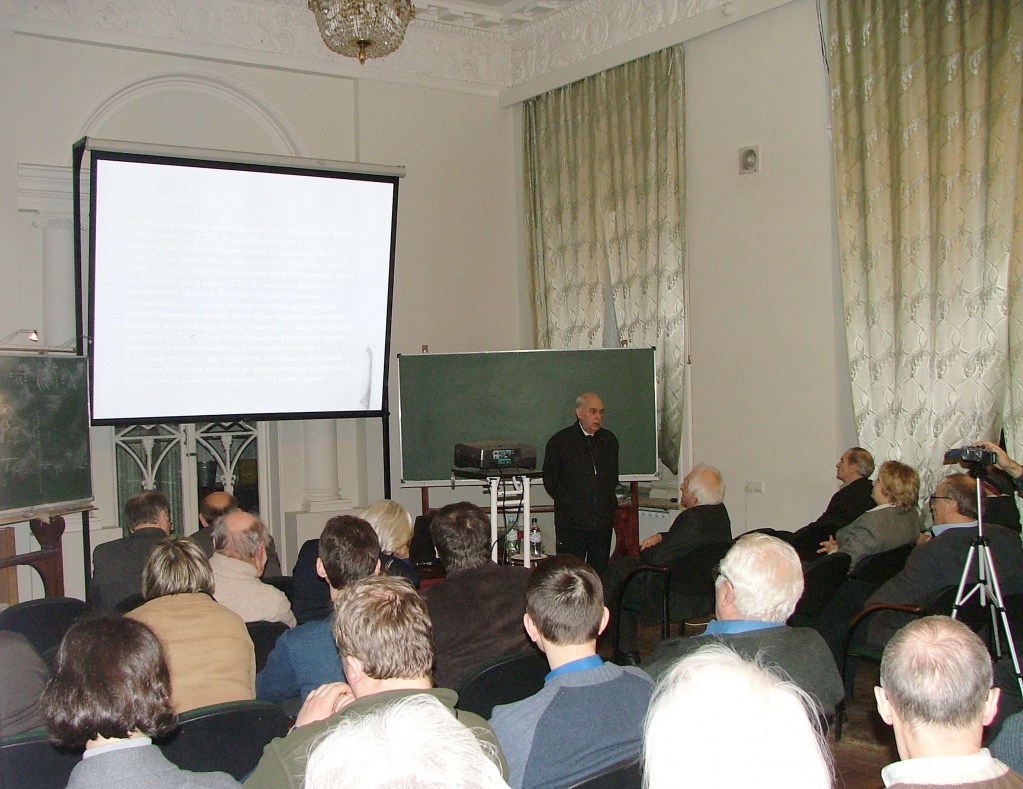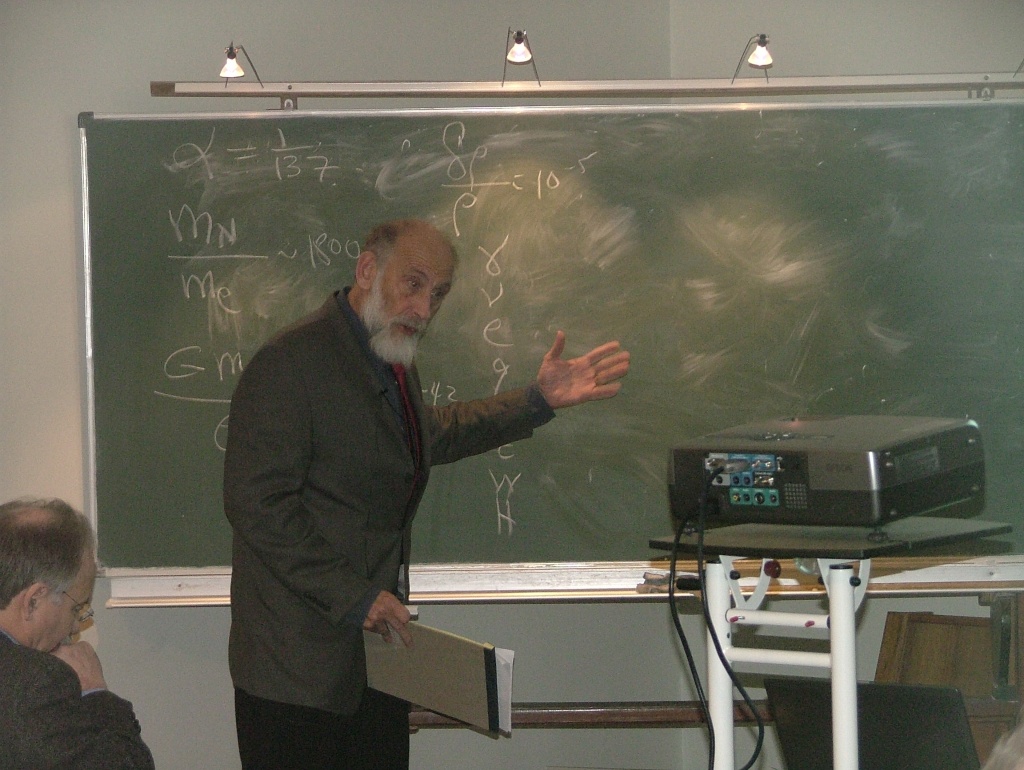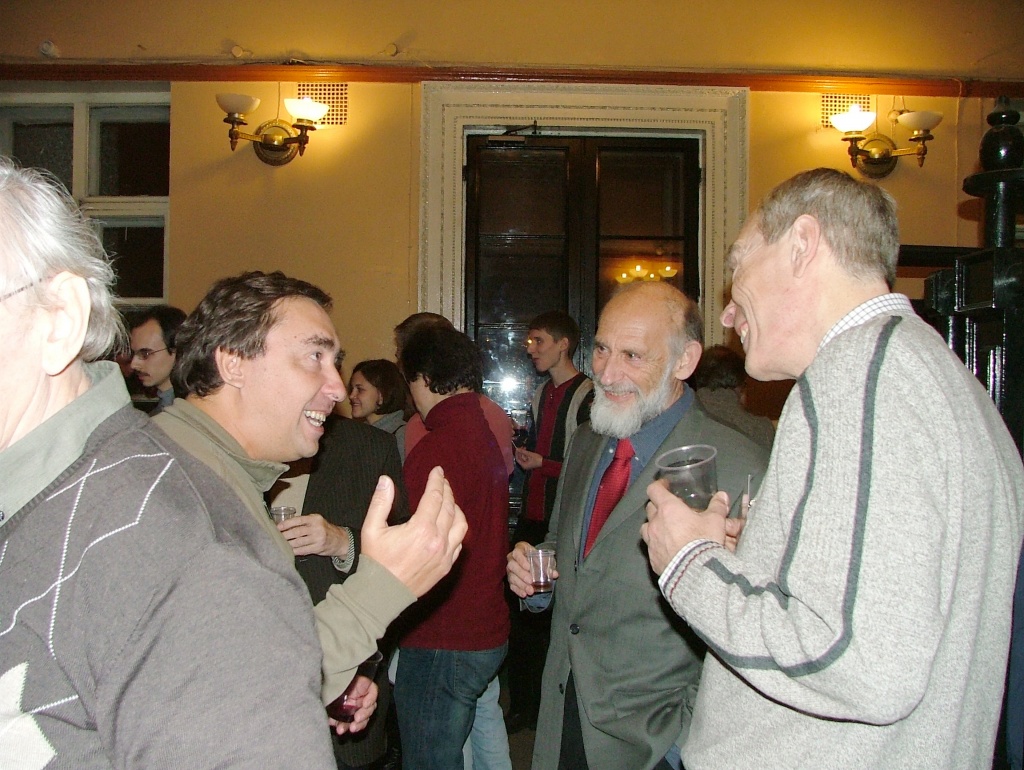2008 - Л.Б. Окунь и L. Susskind
Pomeranchuk Prize Winners 2008
According to the decision of the International Pomeranchuk Prize Committee the Pomeranchuk Prize for 2008 is awarded to Lev Okun (Institute for Theoretical and Experimental Physics, Moscow) and Leonard Susskind (Stanford University)

Pomeranchuk Prize Laureate 2008 Lev Borisovich Okun
gives the lecture at the Ceremony. (February, 9, 2009)
The Prize is awarded to Lev Okun “for creative contribution to elementary particle physics - from weak and electroweak interactions to hadrons, and for excellent books that brought up generations of physicists.”
Professor Lev Borisovich Okun, a full member of the Russian Academy of Sciences, works in ITEP since 1953. Starting from the second half of the 20-th century, there hardly were areas in elementary particle physics where he would have not obtained the pioneering results. The list of his achievements starts from the composite model of hadrons (Sakata-Okun model). In 1958 Okun predicted the . and ..-mesons and introduced the term “hadron” into use. In the joint paper with B.L. Ioffe and A.P. Rudik in 1957 he discovered that fundamental particle-antiparticle symmetry (C-parity) is broken in weak interactions. The work on K-meson mass difference (interaction with .S =2) launched the creation of GIM mechanism and introduction of the fourth quark. The famous Okun-Pomeranchuk theorem (1956) stated the equality of interaction cross sections for particles of the same isomultiplet at asymptotically high energies. In 1970s Okun, together with V.N.Gribov, A.D.Dolgov and V.I.Zakharov, studied the asymptotic behavior of weak interactions
The paper of 1965 with S.B.Pikelner and Ya.B.Zeldovich analyzed the possible concentration of heavy relic particles (in particular, free fractional-charge quarks) in our Universe. At present, this method is used for calculating concentrations of various forms of the dark matter in the Universe. In connection with the discovery of CP-parity non-conservation, L.B.Okun, I.Yu.Kobzarev and I.Ya.Pomeranchuk discussed a "mirror world" connected to our one by gravitation only. The “mirror” matter is a possible candidate for the dark matter.
In 1974, L.B. Okun (with I.Yu.Kobzarev and Ya.B.Zeldovich) considered the formation of domain walls in the Universe. A paper of the same year with I.Yu.Kobzarev and M.B.Voloshin found the quantum tunneling mechanism of metastable vacuum decay, the result being exploited in the theory of the hot Universe. Each of these papers initiated a new direction at the "intersection" of cosmology and elementary particle physics
At the end of the 1970-s, Okun together with A.I.Vainshtein, M.B.Voloshin, V.I.Zakharov, V.A.Novikov and M.A.Shifman suggested the QCD sum rules and applied them to description of particle masses and lifetimes. Long before supersymmetry, a quite amazing work about the existence of bosonic leptons and fermionic mesons appeared

Pomeranchuk Prize Laureates with the Chairman of the
Pomeranchuk Prize Committee A.B.Kaidalov (left)
and A.D.Dolgov
L.Okun published a legendary book "Weak Interaction of Elementary Particles" (1963). The monograph "Leptons and Quarks" (1981, 1990, 2-nd edition) introduced the new gauge theory of electroweak interactions to the readers
Teaching since 1962 at the Chair of Elementary Particle Physics of the Moscow Institute of Physics and Technology (Fiztech), Lev Borisovich brought up a number of known theoreticians and founded a powerful scientific school. His non-academic activities in 90-ies had crucial importance for the survival of science in Russia and other countries of the former Soviet Union.
The international scientific community has expressed high appreciation of the results obtained by L.B.Okun. He was awarded the Matteucci Prize of the Italian Academy of XL (1988), the Lee Page Prize (USA, 1989), the Karpinsky Prize (Germany, 1990), the von Humboldt Prize (Germany, 1993), the Bruno Pontecorvo Prize (Dubna, 1996), the Special prize of the Open Society Institute (1997), and L.D. Landau Golden Medal (RAS, 2002).
The Prize is awarded to Leonard Susskind “for ingenious works on particle physics – from parton model, lattice QCD, and technicolor to cosmology, M-theory and string landscape.”
Leonard Susskind is the Felix Bloch professor of theoretical physics at Stanford University in the field of string theory and quantum field theory since 2000. The list of his main achievements is long and covers a big scope of topics
L. Susskind is widely regarded as one of the fathers of the string theory for his early contributions to the String Theory model of particle physics. He was one of at least three physicists who independently discovered during or around 1970 that the Veneziano dual resonance model of strong interactions could be described by a quantum mechanical model of strings
Susskind has also made contributions in the following areas of physics: the theory of quark confinement, the formulation of Hamiltonian lattice gauge theory, the theory of scaling violations in deep inelastic electroproduction, the theory of symmetry breaking sometimes known as the "technicolor theory".
He proposed the second, yet independent, theory of cosmological baryogenesis. (Sakharov's work was first, but was mostly unknown in the West). He developed the string theory of black hole entropy, introduced the principle of "black hole complementarity", and the holographic principle. He made a conjecture about “M-theory as a matrix model”, introduced holographic entropy bounds in physical cosmology, put forward the idea of an anthropic string theory landscape, and contributed to superstring theory.
Susskind is the author of two popular science books,”The Cosmic Landscape: String Theory and the Illusion of Intelligent Design” published in 2005, and “THE BLACK HOLE WAR: My battle with Stephen Hawking to make the world safe for quantum mechanics” (2009).
Leonard Susskind has been elected to the National Academy of Sciences and the American Academy of Arts and Sciences, and was awarded the 1998 Sakurai Prize for theoretical physics. He is also a distinguished professor at Korea Institute for Advanced Study.









